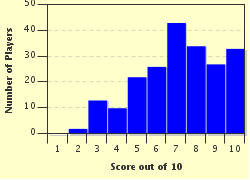Quiz Answer Key and Fun Facts
1. Stephen Foster's classic racing song 'Camptown Races' has a chorus you have heard many times. What word is missing here?
"Goin' to run all night
Goin' to run all day
I bet my money on a _____
Somebody bet on the bay."
2. What famed American race is the subject of Dan Fogelberg's song 'Run for the Roses'?
3. Which crooner, possibly more associated with white Christmases than horse races, made a popular recording of 'Where the Turf Meets the Surf' in 1941?
4. The song 'Molly and Tenbrooks', recorded by Bill Monroe in 1947, is often considered to be the first example of a style of music with which Monroe's name is inextricably linked. Which of these is it?
5. You have probably heard the folk song about the racehorse Stewball, who "never drank water, he only drank wine", and his race against a grey mare and a bay. Is this song based on fact, or is it a complete fiction?
6. On Richard Thompson's 1972 album 'Henry the Human Fly', he performs a song called 'The Angels Took My Racehorse Away'. In what nefarious manner did his horse die, according to the song?
7. In 1948 Spike Jones and His City Slickers recorded a novelty number often called 'Beetlebaum', describing a horse race to the musical accompaniment of a piece of music by Gioachino Rossini. Which of these provided the background for the humorous racecall?
8. In 1973 Tex Morton recorded 'The Goondiwindi Grey', about a famous Australian racehorse who was raced by a syndicate based in Goondiwindi, Queensland. No, I'm not going to ask what color he was - can you tell me his name?
9. In 1975 John Stewart released an album which included a tribute to the famous racehorse Secretariat. What was the song's title?
10. In April of 2012 Australian country music legend Ted Egan released a tribute to a bay mare who has been nicknamed 'The People's Horse', which is the title of his song. What is the name of this modern legend, undefeated in her first 19 races? From her name, I expected to see a horse of a different color when I saw her racing.
Source: Author
looney_tunes
This quiz was reviewed by FunTrivia editor
kyleisalive before going online.
Any errors found in FunTrivia content are routinely corrected through our feedback system.


